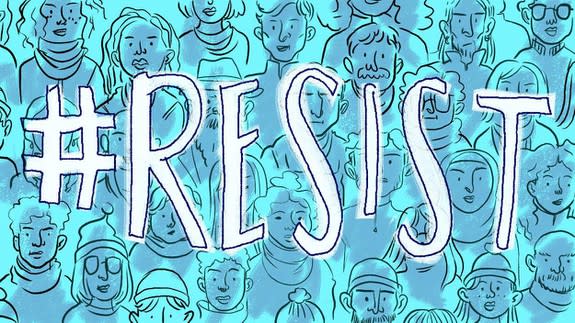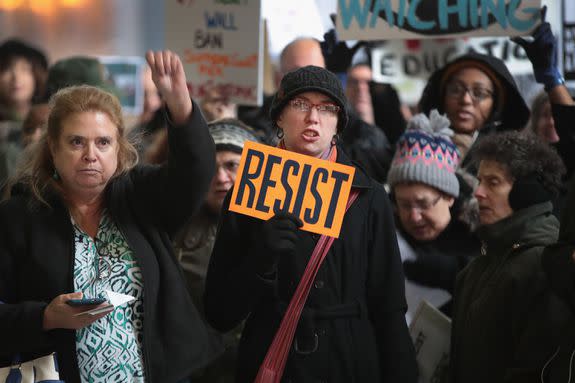One hashtag is uniting Americans in the fight against Trump

Among the millions of vibrant, emotional images of protest packing our timelines since Donald Trump's inauguration, one simple six-letter word has stood out:
Resist.
Variations of the word have dominated social media since the president took office in late January. In the three days following his de-facto Muslim ban, for example, #Resist and #TheResistance have appeared in over 2.5 million tweets, according to data provided by Twitter.
SEE ALSO: Twitter accounts form digital army in resistance against Trump
As the political turmoil brewed, critics of Trump created a range of hashtags — from #IResist to #ResistTrump — to post alongside actions in the fight against the policies of the new president.
These posts — and the IRL actions behind them, from marches to calls to congressional representatives — have all morphed into a new social movement. At the moment, it's a movement that appears to have no set name, no particular agenda and no single organizing force.
Unlike the #WomensMarch or #BlackLivesMatter, for instance, #TheResistance happened almost overnight and through a totally decentralized collection of people with no one person or group leading the way.
But it's made it way all the way to the White House, where a giant Greenpeace banner hanging from a crane seemed to spur its popularity even more.
This morning seven activists deployed a 70-ft by 35-ft banner that reads “RESIST” above the White House. This was call for YOU. #ResistOften pic.twitter.com/CVbr9VNZBu
— Greenpeace USA (@greenpeaceusa) January 26, 2017
Although it has been embraced by a wide swath of Americans, #Resist has come to symbolize the fight for all those most vulnerable under Trump — immigrants, Muslims, people of color, women, members of the LGTBQ community and anyone else who feels they have been targeted by his policies.
"They're worried they're going to lose what [rights] they have gained," said David Lyons, a legal philosopher at Boston University, noting that members of the LGBTQ community, for instance, only very recently secured the fundamental right of marriage equality.
"So they are resisting."
We're not going to shut up. We're going to resist. Stand with @SenateDems tonight at the Supreme Court. https://t.co/Ny57jNFcnt
— Bernie Sanders (@SenSanders) January 30, 2017
People are also latching onto the word through efforts like #ResistTrumpTuesdays, which feature sit-ins, street protests and visits to local representatives' offices to challenge the president's agenda.
What's happening right now is "very spontaneous" and unfolding through the ad-hoc efforts of everyday people, according to Lyons, who has studied political resistance for decades. These are people making their own signs, showing up to protest because of a string of tweets, and making donations out of their own pockets.
"There's no better term to describe it," Lyons said. "Resistance is the only term that describes the great variety of actions happening right now."

Image: scott olson/ Getty Images
Of course, political resistance is nothing new but it's that timeless energy of civic action that seems to be burning in the hearts and minds of millions of Americans right now. And all of it pooled together makes up a broader movement, one the New York Times describes as "hatched on social networks and ... dispatched by mobile phones."
"Unlike the Tea Party and the white-supremacist 'alt-right,' the new movement has no name," the Times' journalist Farhad Manjoo writes. "Call it the alt-left, or, if you want to really drive Mr. Trump up the wall, the alt-majority. Or call it nothing."
From right-to-work protests in middle America to #BlackLivesMatter demonstrations around the country, a wide array of groups are coming together to #Resist. Still, #TheResistance can be seen burning most brightly in the coastal liberal enclaves of the United States, as shown in a heat map by Affinio.

Image: affinio
It may have its geographic biases, but the resistance to Trump appears largely united, with solidarity being seen as the only way forward.
"They can’t just care [only] about women’s rights or gay rights or the rights of black people" or any other individual group being oppressed, said Clifford Lampe, a professor of information at the University of Michigan who studies online social movements. "You kind of have to support that whole thing as a package now."
Hashtags spring up in response to a variety of issues, from natural disasters to instances of police brutality, but outside of a few notable exceptions such as #BlackLivesMatter, they tend to burn out after a period of time. #Resist could be different, Lampe believes, because few movements have affected as many people simultaneously as Trump's agenda. "There are very few events where it touches so many different people's lives," he said.
This can be seen across social media, as celebrities, politicians, advocacy groups, activists, and countless ordinary Americans rally to fight back, enlisting the #Resist hashtag to represent any expression of opposition.
As Trump continues to govern with ferocity, the #Resist hashtag continues to grow. It appears, no matter what you want to call it, The Resistance has arrived.
A Timeline of #Resist
From the first hours of his presidency to the moment he issued a travel ban targeting Muslims, Americans have been saying they will #Resist.
November: Trump is elected, a hashtag is born
Nov. 8, 2016 is a day many Americans will never forget. Jaws dropped and tears ran down the faces of Trump detractors around the nation, but within days, some had already worked up a commitment to resistance. The hashtag began percolating.
We won't tolerate any normalization of the white supremacists currently attempting a government coup #TheResistance #Resist #NotMyPresident
— Tara Obama Dublin❄️ (@taradublinrocks) November 19, 2016
You can't unite with hate. #Chicago demonstration #Resist pic.twitter.com/rUEqhH3Ogv
— Betsy Rubin (@BetsyRubin) November 19, 2016
I am with the First Lady, Michelle Obama. I am refusing to say his name. We should all refuse to say his name. #resist
— Roberta Brooks (@Roberta823) November 11, 2016
December: #NoDAPL protesters earn a victory
The battle to halt construction on the Dakota Access Pipeline, a 1,172-mile oil pipeline that will run through four states, saw many using the hashtag to advocate the rights of indigenous people, environmental safety and water quality, and to call for more progressive civic action. On Dec. 5, construction on the pipeline was temporarily put on hold.
Keep it in the soil you can't drink oil #WaterIsLife #NoDAPL #dumptrump #blacklivesmatter #abolishborders #resist pic.twitter.com/9UBQbCicTU
— Aaron Tanaka (@tanakatalk) November 10, 2016
Poster by artist Juan Fuentes (https://t.co/EYGgTmGoaj) for #StandingRockSiouxTribe #standingrock #noDAPL #art #RESIST #sanfrancisco #sf pic.twitter.com/Zf4qwdkiAr
— openchakra (@openchakra) December 8, 2016
January: The Women's March overshadows the president's inauguration
The day after Trump was sworn into office, millions of Americans showed him exactly how they felt about his presidency. And the resistance was real. #Resist tied protests across to country to a single word.
They tried to bury us.
They didn't know we were seeds. #Resist #womensmarch #whywemarch https://t.co/3sdxZIWzOn pic.twitter.com/GidnNIck1e— Lauren M Baker (@LMBMedia) January 23, 2017
This is what it looks like when 750,000 people #Resist pic.twitter.com/25JNIeQ9WV
— Sam Underwood (@samunderwood) January 22, 2017
Happy to see Democracy alive and well#resist #nycwomensmarch pic.twitter.com/Jp3vfIUQsN
— Ryan Eggold (@Ryan_Eggold) January 21, 2017
Flash protests break out after Trump announces Muslim ban
Massive flash protests at airports around the country showed just how quickly Americans will spring into action. Lawyers, translators, and activists rushed to defend those facing uncertainty under a travel ban placed on seven Muslim-majority counties. Of course, #Resist was there all the way.
Lawyers at Chicago O'hare Airport are filing 8 Habeas Petitions as we speak. ✊🏾✊🏽✊🏼#MuslimBan #nobannowall #OhdTerminal5 #resist #DumpTrump pic.twitter.com/dQLKYQQi8m
— Sarah Chambers (@Sarah4Justice) January 29, 2017
@AltStateDpt Los Angeles Intl Airport today. #resist #NoBanNoWall #SkandiaShafer pic.twitter.com/sebJ8StmOU
— Jessica Craven (@Craven7Jessica) January 30, 2017
Standing with hundreds at the MSP Airport today against the #MuslimBan.
Find a protest and #resist: https://t.co/p3DjDtc4Hy pic.twitter.com/qdjq3xWYDn— Keith for DNC (@EllisonCampaign) January 29, 2017
Activism becomes a regular, scheduled activity with #ResistTrumpTuesdays
Following the rise of the hashtag comes #ResistTrumpTuesdays, a collection of loosely organized efforts by groups such as the Working Families Party to appeal to local lawmakers and march on the streets.
Ok let's make this a thing #ResistTrumpTuesdays pic.twitter.com/0fXMUn0A2W
— Joseph Pfender (@Apollonysus) February 1, 2017
"In 1934 in the Great Depression I was still able get a BA with no loans—union people fought for & WON free higher ed" #ResistTrumpTuesdays pic.twitter.com/9AVeq5gaBE
— Resist Trump Chicago (@ResistTrumpTues) January 31, 2017
#ResistTrumpTuesdays protest in Chicago calling on @SenatorDurbin and @SenDuckworth to vote NO on DeVos & Sessions & all Trump appointees. pic.twitter.com/rDCu9eqTQF
— Love+Struggle Photos (@sarahdashji) January 31, 2017
February: The hashtag continues
Celebrities, digital influencers, popular activists, advocacy groups and politicians have all flocked to the term. Their support sees the #resist hashtag find its home in the social media feeds of all Americans.
Blessed to live in a time where I have the freedom to wear what I want. Happy World Hijab Day 🇺🇸❤ #resist pic.twitter.com/f23Cq5RHA0
— Ibtihaj Muhammad (@IbtihajMuhammad) February 1, 2017
The GOP leadership has cravenly capitulated to Trump's immigration ban. We look to our brave federal judiciary to check his madness. #Resist
— George Takei (@GeorgeTakei) January 29, 2017
help our queer & immigrant friends. send me your donation receipts for the @aclu & I will match up to $100K https://t.co/P9zVRH0WH0 #RESIST
— sia (@Sia) January 28, 2017

